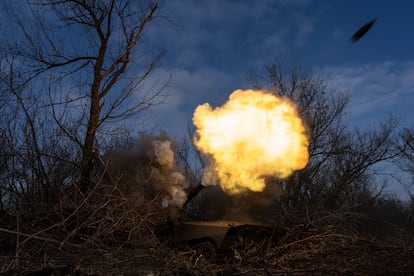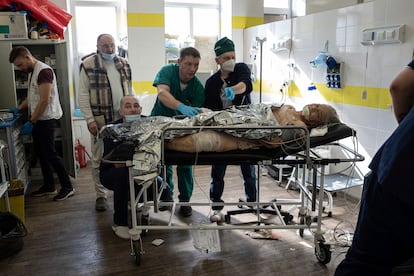Russian advance in Bakhmut could come with heavy losses
Ukraine has destroyed key bridges over the river, while sniper fire from fortified buildings further west has made the thin strip of open ground in the city’s center “a killing zone”

Russian forces have made progress in their campaign to capture the city of Bakhmut in eastern Ukraine, the focus of the war’s longest ground battle, but their assault will be difficult to sustain without more significant personnel losses, British military officials said Saturday.
The UK Defense Ministry said in its latest assessment that paramilitary units from the Kremlin-controlled Wagner Group have seized most of eastern Bakhmut, with a river flowing through the city now marking the front line of the fighting.
The mining city is located in Donetsk province, one of four regions of Ukraine that Russian President Vladimir Putin illegally annexed last year. Russia’s military opened the campaign to take control of Bakhmut in August, and both sides have experienced staggering casualties.
Ukrainian troops and supply lines remain vulnerable to “continued Russian attempts to outflank the defenders from the north and south” as the Wagner Group’s forces try to close in on them in a pincer movement, the UK ministry said.
However, the ministry added, it will be “highly challenging” for Wagner’s soldiers to push ahead because Ukraine has destroyed key bridges over the river, while Ukrainian sniper fire from fortified buildings further west has made the thin strip of open ground in the city’s center “a killing zone.”
Russian military bloggers and other pro-Kremlin Telegram accounts claimed Friday that Russian forces had entered a metal processing plant in northwestern Bakhmut. The Institute for the Study of War, a Washington-based think tank, also referenced geolocated footage showing Russian forces within 800 meters of the AZOM plant, a heavily built-up and fortified complex.
The institute reported in its Friday night assessment that Moscow’s apparent focus on capturing the plant, rather than opting for a “wider encirclement of western Bakhmut” by attempting to take nearby villages, was likely to bring a further wave of Russian casualties.
Ukraine’s ground forces on Saturday signaled their intention to hold out in Bakhmut, announcing on Facebook that their top officer was personally overseeing “the most important sectors of the front” to deny Moscow a long-awaited battlefield victory.
The post did not clarify whether Col. Gen. Oleksandr Syrskyi was in Bakhmut at the time of the Facebook post, although he has made several visits to the city and other front-line hot spots in eastern Ukraine in the past month.
Meanwhile, repair work continued Saturday across Ukraine following a massive Russian missile and drone strike two days earlier that killed six people and left hundreds of thousands without heat or electricity.

Ukraine’s state grid operator said power supply issues persisted across four provinces following the barrage, in which 80 Russian missiles and a smaller number of exploding drones hit residential buildings and critical infrastructure across the country.
In a Facebook post, Ukrenergo said scheduled blackouts remain in place in Kharkiv and Zhytomyr, as well as parts of the Dnipropetrovsk and Mykolaiv regions. The company added that the situation in Zhytomyr was especially challenging, with some customers still without power.
Russian shelling on Saturday set a car driving through the southern city of Kherson on fire, killing one person inside and wounding two others, regional Gov. Oleksandr Prokudin said in a Telegram post.
Earlier, authorities had reported that Russian shelling between Friday morning and Saturday morning killed at least five people and wounded another 19 across Ukraine’s Kherson and Donetsk provinces.
Donetsk, where Bakhmut is located, has been the epicenter of the fighting in recent months, while Ukrainian-held parts of the Kherson region have seen daily shelling from Russian troops stationed across the Dnieper River.
Ukrainian defense chief Oleksiy Reznikov welcomed his Norwegian counterpart to Kyiv on Saturday. Defense Minister Bjørn Arild Gram announced Norway’s decision to earmark $7.5 billion over the next five years for weapons and other aid for Ukraine.
According to a readout of the meeting published by Ukraine’s Defense Ministry, Gram said the arms Norway planned to send included missile launchers and ammunition for NASAMS anti-aircraft systems.
Reznikov said that Ukrainian troops successfully operated some of the same weapons to shoot down the drones and missiles that Russia rained on Ukraine on Thursday.
“We know for sure that every 10 uses of the NASAMS system (...) mean downing 10 of the aggressor’s missiles, saving 10 buildings and infrastructure facilities, as well as hundreds of human lives,” he said.
Sign up for our weekly newsletter to get more English-language news coverage from EL PAÍS USA Edition
Tu suscripción se está usando en otro dispositivo
¿Quieres añadir otro usuario a tu suscripción?
Si continúas leyendo en este dispositivo, no se podrá leer en el otro.
FlechaTu suscripción se está usando en otro dispositivo y solo puedes acceder a EL PAÍS desde un dispositivo a la vez.
Si quieres compartir tu cuenta, cambia tu suscripción a la modalidad Premium, así podrás añadir otro usuario. Cada uno accederá con su propia cuenta de email, lo que os permitirá personalizar vuestra experiencia en EL PAÍS.
¿Tienes una suscripción de empresa? Accede aquí para contratar más cuentas.
En el caso de no saber quién está usando tu cuenta, te recomendamos cambiar tu contraseña aquí.
Si decides continuar compartiendo tu cuenta, este mensaje se mostrará en tu dispositivo y en el de la otra persona que está usando tu cuenta de forma indefinida, afectando a tu experiencia de lectura. Puedes consultar aquí los términos y condiciones de la suscripción digital.
More information
Archived In
Últimas noticias
Most viewed
- Reinhard Genzel, Nobel laureate in physics: ‘One-minute videos will never give you the truth’
- Oona Chaplin: ‘I told James Cameron that I was living in a treehouse and starting a permaculture project with a friend’
- Pablo Escobar’s hippos: A serious environmental problem, 40 years on
- Charles Dubouloz, mountaineering star, retires at 36 with a farewell tour inspired by Walter Bonatti
- Why we lost the habit of sleeping in two segments and how that changed our sense of time









































